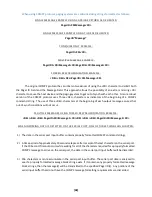
[35]
APPENDIX B – COM PORT SETTINGS
You may be required to configure the COM port settings in the paging system to establish the
operating mode and serial parameters. These are programmable using the Paging Encoder Setup v9 Software
available on our website at:
https://www.wirelessmessaging.com/sps5-series-encoder-programming
. To get
to the COM port settings in the Paging Encoder Setup v9 Software, in the
MAIN WINDOW
click on
SETTINGS
.
Some of the less used settings will be under
ADVANCED SETTINGS
. You can also use Web Configuration
(
pgs. 20-21
) to make these changes as well.
Your WaveWare v9E Paging System typically communicates with a PC or other host system via RS-
232 at
9600 Baud, No Parity, 8 data bits, and 1 stop bit
. You can configure the paging system for other serial
communication parameters.
THE AVAILABLE OPERATING MODES INCLUDE:
TAP & COMP2 VERBOSE:
The paging system includes readable replies after each paging request is received.
WAVEWARE & SCOPE:
Both of these use proprietary single serial commands that include capcode, function
code, RF baud rate, and message values. Either protocol can be used in a Simplex or Duplex Operation.
TAP NON-VERBOSE:
It reduces the paging system response to 3-digit numeric codes.
COMP2 NON-VERBOSE:
In the COMP2 Non-Verbose mode the response is reduced to none at all.
COMP1:
Any data received on the serial port will be sent to all pagers in Group 1 stored in
PAGER GROUPS
.
Refer to Appendix H for a definition of the COMP1 Protocol.
The Non-Verbose modes are useful in situations where you want to minimize the serial data
throughput requirements which tend to allow paging messages to be delivered more quickly, or to achieve
compatibility with legacy host systems.
Refer to Appendix A for a definition of the TAP Protocol and Appendix
I for a definition of the COMP2 Verbose and Non-Verbose Protocols
. Independent of operating modes, you
can configure the Serial Port Baud and Parity, and you can configure whether Hardware or Software Flow
Control is used.
THERE ARE 2 FLOW CONTROL METHODS:
HARDWARE FLOW CONTROL MODE
: The RS-232 CTS signal will be de-asserted when the input buffer
doesn’t have capacity for another Message Block, and re-asserted when capacity exists in the input buffer.
SOFTWARE FLOW CONTROL MODE
: An <XOFF> Character (0x11) will be outputted in the response string
to indicate that the input buffer doesn't have capacity for another Message Block. When capacity is available,
an <XON> Character (0x13) will be outputted.






























